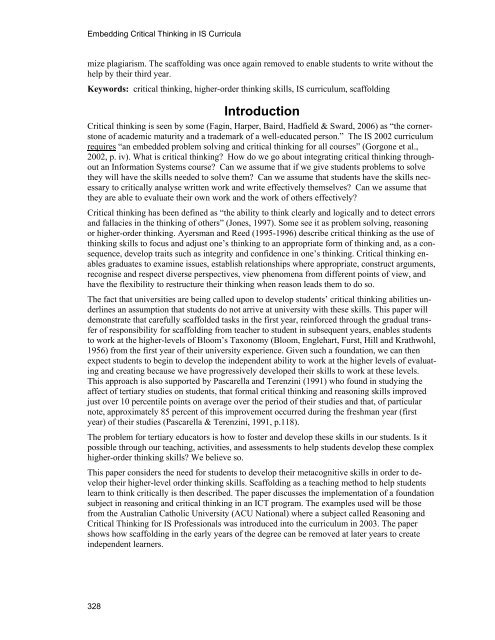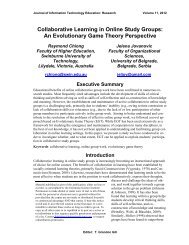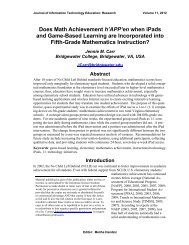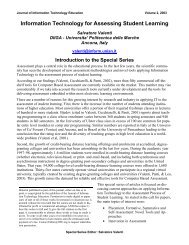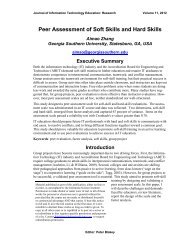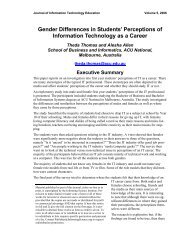Put Title Here Using Heading 1 Style - Journal of Information ...
Put Title Here Using Heading 1 Style - Journal of Information ...
Put Title Here Using Heading 1 Style - Journal of Information ...
You also want an ePaper? Increase the reach of your titles
YUMPU automatically turns print PDFs into web optimized ePapers that Google loves.
Embedding Critical Thinking in IS Curricula<br />
mize plagiarism. The scaffolding was once again removed to enable students to write without the<br />
help by their third year.<br />
Keywords: critical thinking, higher-order thinking skills, IS curriculum, scaffolding<br />
Introduction<br />
Critical thinking is seen by some (Fagin, Harper, Baird, Hadfield & Sward, 2006) as “the cornerstone<br />
<strong>of</strong> academic maturity and a trademark <strong>of</strong> a well-educated person.” The IS 2002 curriculum<br />
requires “an embedded problem solving and critical thinking for all courses” (Gorgone et al.,<br />
2002, p. iv). What is critical thinking? How do we go about integrating critical thinking throughout<br />
an <strong>Information</strong> Systems course? Can we assume that if we give students problems to solve<br />
they will have the skills needed to solve them? Can we assume that students have the skills necessary<br />
to critically analyse written work and write effectively themselves? Can we assume that<br />
they are able to evaluate their own work and the work <strong>of</strong> others effectively?<br />
Critical thinking has been defined as “the ability to think clearly and logically and to detect errors<br />
and fallacies in the thinking <strong>of</strong> others” (Jones, 1997). Some see it as problem solving, reasoning<br />
or higher-order thinking. Ayersman and Reed (1995-1996) describe critical thinking as the use <strong>of</strong><br />
thinking skills to focus and adjust one’s thinking to an appropriate form <strong>of</strong> thinking and, as a consequence,<br />
develop traits such as integrity and confidence in one’s thinking. Critical thinking enables<br />
graduates to examine issues, establish relationships where appropriate, construct arguments,<br />
recognise and respect diverse perspectives, view phenomena from different points <strong>of</strong> view, and<br />
have the flexibility to restructure their thinking when reason leads them to do so.<br />
The fact that universities are being called upon to develop students’ critical thinking abilities underlines<br />
an assumption that students do not arrive at university with these skills. This paper will<br />
demonstrate that carefully scaffolded tasks in the first year, reinforced through the gradual transfer<br />
<strong>of</strong> responsibility for scaffolding from teacher to student in subsequent years, enables students<br />
to work at the higher-levels <strong>of</strong> Bloom’s Taxonomy (Bloom, Englehart, Furst, Hill and Krathwohl,<br />
1956) from the first year <strong>of</strong> their university experience. Given such a foundation, we can then<br />
expect students to begin to develop the independent ability to work at the higher levels <strong>of</strong> evaluating<br />
and creating because we have progressively developed their skills to work at these levels.<br />
This approach is also supported by Pascarella and Terenzini (1991) who found in studying the<br />
affect <strong>of</strong> tertiary studies on students, that formal critical thinking and reasoning skills improved<br />
just over 10 percentile points on average over the period <strong>of</strong> their studies and that, <strong>of</strong> particular<br />
note, approximately 85 percent <strong>of</strong> this improvement occurred during the freshman year (first<br />
year) <strong>of</strong> their studies (Pascarella & Terenzini, 1991, p.118).<br />
The problem for tertiary educators is how to foster and develop these skills in our students. Is it<br />
possible through our teaching, activities, and assessments to help students develop these complex<br />
higher-order thinking skills? We believe so.<br />
This paper considers the need for students to develop their metacognitive skills in order to develop<br />
their higher-level order thinking skills. Scaffolding as a teaching method to help students<br />
learn to think critically is then described. The paper discusses the implementation <strong>of</strong> a foundation<br />
subject in reasoning and critical thinking in an ICT program. The examples used will be those<br />
from the Australian Catholic University (ACU National) where a subject called Reasoning and<br />
Critical Thinking for IS Pr<strong>of</strong>essionals was introduced into the curriculum in 2003. The paper<br />
shows how scaffolding in the early years <strong>of</strong> the degree can be removed at later years to create<br />
independent learners.<br />
328


